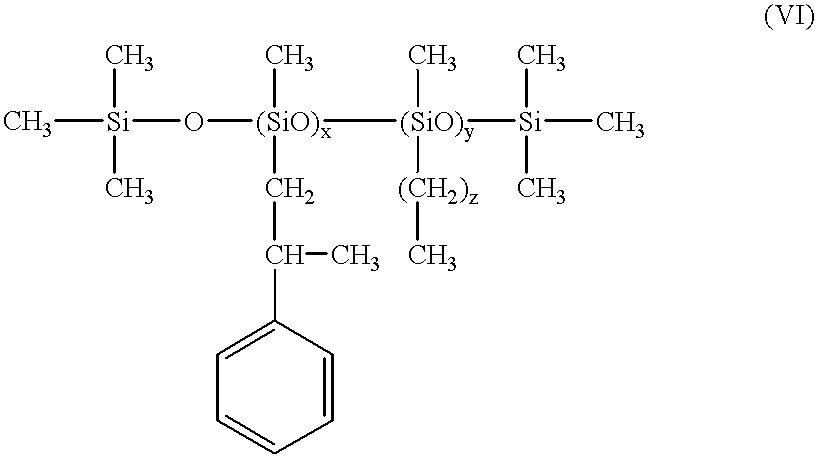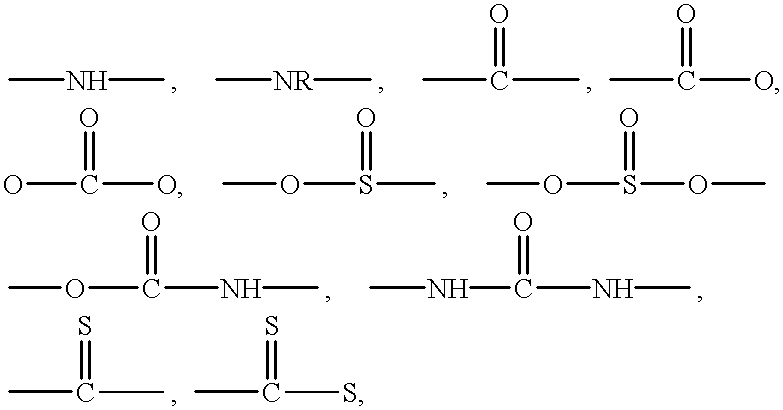Paintable organopolysiloxane mold release compositions and processes for their use
a technology of organopolysiloxane and composition, which is applied in the field of paintable organopolysiloxane, can solve the problems of inability to produce parts without effective mold release, inability to meet modern high-speed production rates, and inability to use soaps with high-efficiency soaps, etc., and achieves the effect of small particle siz
- Summary
- Abstract
- Description
- Claims
- Application Information
AI Technical Summary
Benefits of technology
Problems solved by technology
Method used
Image
Examples
example 1
A blend (A) is prepared by mixing 1 weight percent of an aminofunctional dimethylpolysiloxane with 99 weight percent Organosilicone Fluid L-42 produced by Witco Corporation, Organosilicones Group. A second blend (B) is prepared by mixing 1 weight percent of an aminofunctional dimethylpolysiloxane with 99 weight percent Release Agent TN produced by Wacker Chemie. The aminofunctional dimethylpolysiloxane fluid has an amine content of 0.0014 equivalents per gram (1.4 meq / g), a methoxy content of 7 weight percent, a viscosity of about 20 cSt, and an amine functionality which is a silsesquioxane group containing an aminoethylaminopropyl group. The (A) blend is clear and the (B) blend is cloudy. Both blends are formulations within the scope of the invention.
Each blend is applied to two molds and the procedure of Comparison Example C1 is followed to make molded parts. One part is painted immediately and the second part is painted after the surface of the part is wiped with a paper towel. T...
example 2
A blend (C) is prepared by mixing 1 weight percent of a mercaptan-functional dimethylpolysiloxane with 99 weight percent Release Agent TN. The mercaptan-functional dimethylpolysiloxane contains about 0.8 weight percent of SH groups, has a viscosity of about 70 cSt, and the mercaptan functionality is borne by a silsesquioxane group having an attached mercaptopropyl group. The resultant cloudy blend is centrifuged for one hour at 3000 rpm. A sample is withdrawn from the top and bottom. The mercaptan (SH) content is determined by titrating the blend with silver nitrate. The top is found to have 0.008 weight percent SH and the bottom is found to have 0.008 weight percent SH. The ratio of functional groups in the top to functional groups in the bottom is 1.0. Two urethane parts are prepared following the procedure of Comparison Example C1. One pound of force is required to remove the parts from the molds. The first part is painted and the coating, is very uneven and the paint does not co...
example 5
A blend (F) is prepared by mixing 5 weight percent aminofunctional dimethylpolysiloxane with 95 weight percent Release Agent TN produced by Wacker-Chemie. The aminofunctional dimethylpolysiloxane fluid has an amine content of 0.0014 equivalents per gram (1.4 meq / g), a methoxy content of 7 weight percent, a viscosity of about 20 cSt, and has amine functionality in silsesquioxane groups containing an aminoethylaminopropyl group. The (F) blend is cloudy. The blend is centrifuged for one hour at 3000 rpms. A sample from the top and bottom is titrated for amine content. The top contains 0.000067 equivalents per gram and the bottom contains 0.000085 equivalents per gram. The ratio of functional groups in the top to functional groups in the bottom is 0.79.
A solution consisting of 5 weight percent of the (F) blend in xylene is applied to two molds and the procedure of Comparison Example C1 is followed to make molded parts. One part is painted immediately and the second part was painted afte...
PUM
| Property | Measurement | Unit |
|---|---|---|
| mole ratio | aaaaa | aaaaa |
| mole ratio | aaaaa | aaaaa |
| particle sizes | aaaaa | aaaaa |
Abstract
Description
Claims
Application Information
 Login to View More
Login to View More - R&D
- Intellectual Property
- Life Sciences
- Materials
- Tech Scout
- Unparalleled Data Quality
- Higher Quality Content
- 60% Fewer Hallucinations
Browse by: Latest US Patents, China's latest patents, Technical Efficacy Thesaurus, Application Domain, Technology Topic, Popular Technical Reports.
© 2025 PatSnap. All rights reserved.Legal|Privacy policy|Modern Slavery Act Transparency Statement|Sitemap|About US| Contact US: help@patsnap.com



